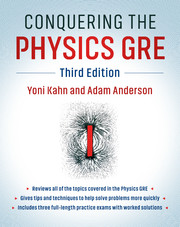Book contents
- Frontmatter
- Contents
- Preface
- How to Use This Book
- Resources
- 1 Classical Mechanics
- 2 Electricity and Magnetism
- 3 Optics and Waves
- 4 Thermodynamics and Statistical Mechanics
- 5 Quantum Mechanics and Atomic Physics
- 6 Special Relativity
- 7 Laboratory Methods
- 8 Specialized Topics
- 9 Special Tips and Tricks for the Physics GRE
- Sample Exams and Solutions
- References
- Equation Index
- Subject Index
- Problems Index
How to Use This Book
Published online by Cambridge University Press: 16 February 2018
- Frontmatter
- Contents
- Preface
- How to Use This Book
- Resources
- 1 Classical Mechanics
- 2 Electricity and Magnetism
- 3 Optics and Waves
- 4 Thermodynamics and Statistical Mechanics
- 5 Quantum Mechanics and Atomic Physics
- 6 Special Relativity
- 7 Laboratory Methods
- 8 Specialized Topics
- 9 Special Tips and Tricks for the Physics GRE
- Sample Exams and Solutions
- References
- Equation Index
- Subject Index
- Problems Index
Summary
Studying for the GRE can be overwhelming! This book is long because it contains all the information you need to ace the exam, but not every student needs to study every chapter in equal detail. Here are some suggestions for how to use this book.
• Only numbered equations are worth remembering. The Physics GRE is a test of outside knowledge, so some memorization is inevitable. However, we have made a concerted effort to separate equations that are only used in specific worked examples from equations that are worth remembering for the test. Only the equations worth remembering are given equation numbers and are included in the Equation Index at the back of the book along with the page number where they appear; anything else you can safely forget for test day. This is still quite a long list, so rather than memorize each equation, check out Chapter 9 for suggestions on how to reduce your memorization workload by deriving more complex equations from more basic ones.
• Use these sample exams as diagnostics. ETS has released precious few actual GREs, and only the most recent (from 2001, 2008, and 2017) are representative of the current content of the test. We strongly suggest you leave the ETS exams until shortly before the actual test, where you can take them under simulated test-taking conditions. To start your studying, consider taking one of the sample exams provided in this book as a diagnostic, and note which areas you need to review the most. You can then focus on the review chapters covering these particular subject areas. Once you feel you've sufficiently filled in the gaps in your knowledge of undergraduate physics, you can take another sample exam and track your improvement, leaving the last exam for extra practice a week or two before the test, should you need it. Because we don't have access to ETS's proprietary scoring formula, we do not attempt to offer any conversion between raw score and scaled score (200–990) for our sample exams. Guessing at a formula would be extremely misleading at best, so use your score on our exams only as an estimate, but by all means use the ETS-provided conversion charts when taking the ETS exams.
- Type
- Chapter
- Information
- Conquering the Physics GRE , pp. xiPublisher: Cambridge University PressPrint publication year: 2018

